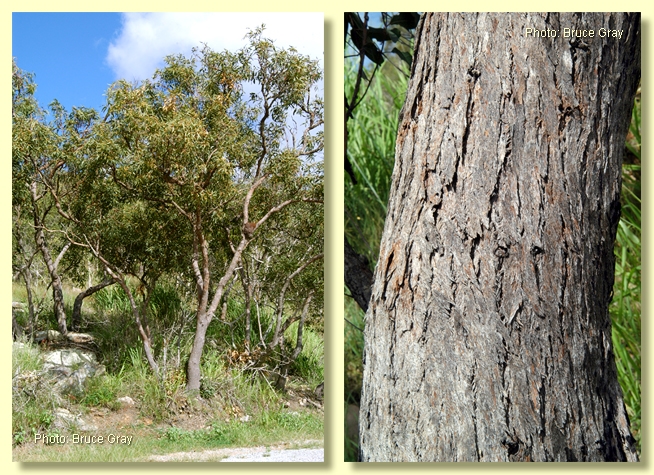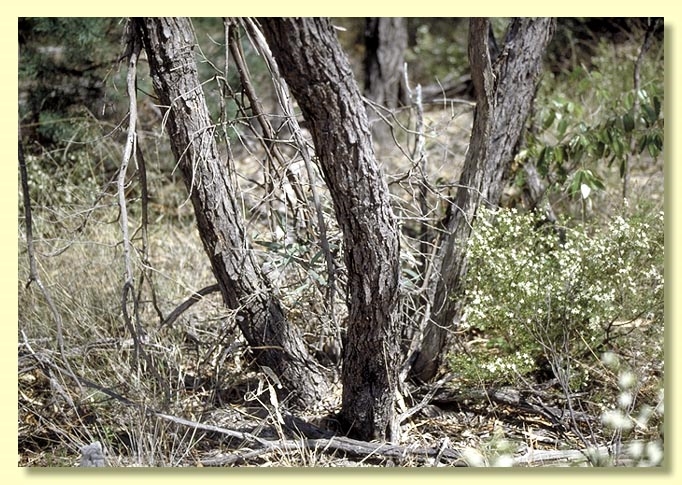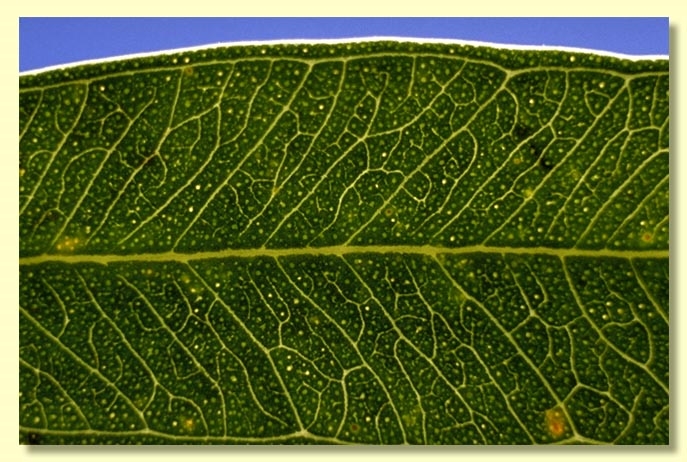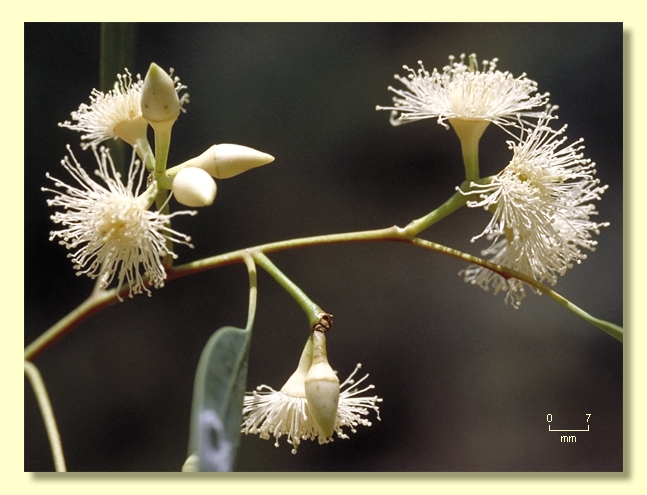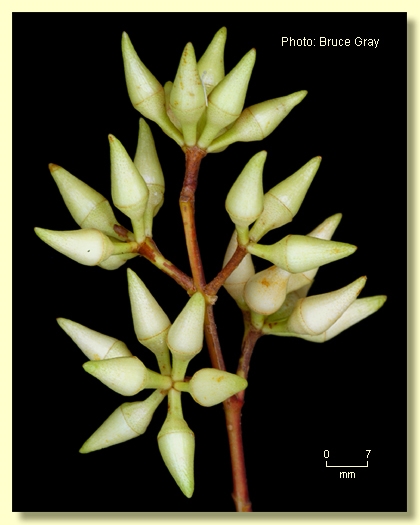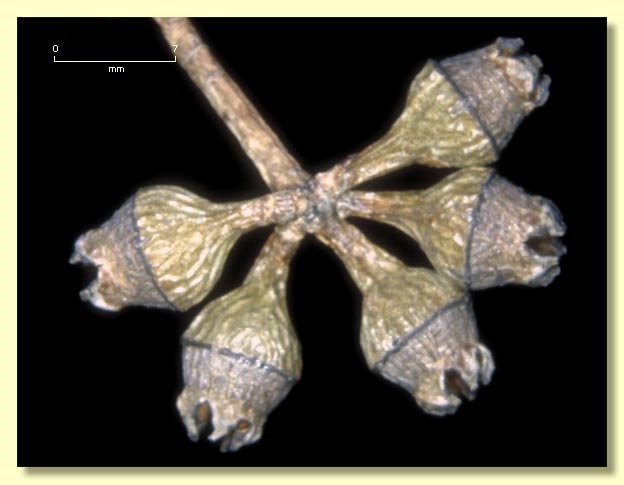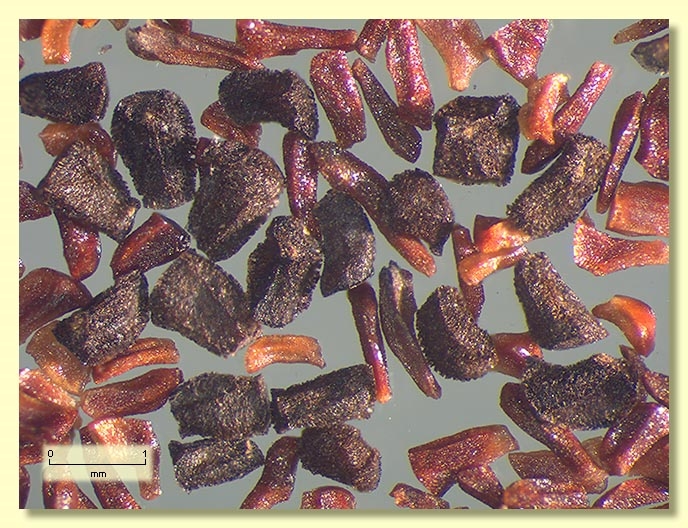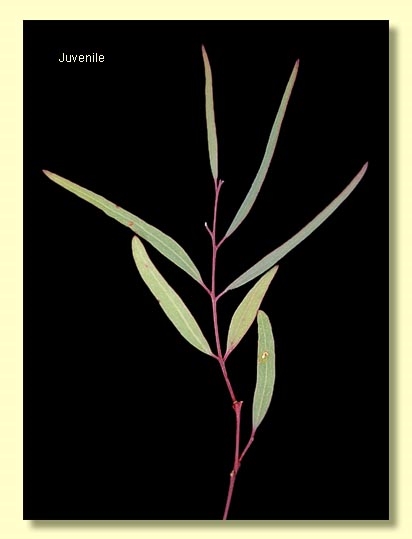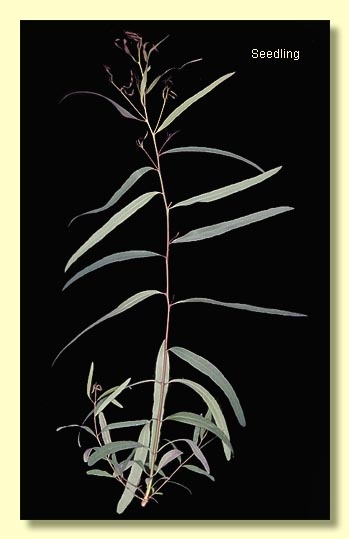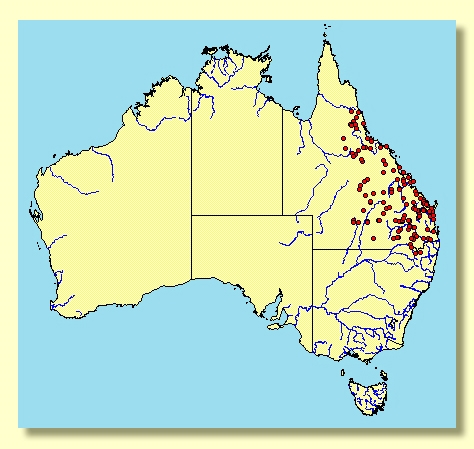Euclid - Online edition
Eucalyptus exserta
Eucalyptus | Symphyomyrtus | Exsertaria | Phaeoxylon
T: Burnett R., Qld, F.Mueller s.n.; holo: MEL; iso: K.
E. insulana F.M.Bailey, Queensland Agric. J. 17: 103 (1906). T: Middle Percy Island, Qld., Dec. 1905, H.Tryon s.n.; iso: K, MEL, NSW.
E. exserta var. parvula Blakely, Key Eucalypts 129 (1934). T: Brian Pastures, Gayndah, Qld, July 1903, S.A.Lindeman s.n.; syn: NSW; Maryborough West, Qld, 26 Oct. 1918, P.J.McGrath s.n.; syn: NSW; Duaringa, Qld, Mar. 1909, J.H.Maiden s.n.; syn: NSW.
Bark rough, usually to small branches, hard, fissured and fibrous, grey.
Juvenile growth (coppice or field seedlings to 50 cm): stem square or rounded in cross-section; juvenile leaves shortly petiolate, opposite for 4 to 7 pairs, then alternate, linear to falcate or narrowly lanceolate, 6–19 cm long, 0.3–1.3 cm wide, dull, usually green.
Adult leaves alternate, petiole (0.5)0.8–2 cm long; blade narrowly lanceolate to lanceolate, 6.5–18 cm long, 0.7–2.7 cm wide, base tapering to petiole, concolorous, slightly glossy or dull, usually green, side-veins greater than 45° to midrib, sparsely to moderately reticulate, intramarginal vein parallel to and remote from margin, oil glands island.
Inflorescence axillary unbranched, peduncles 0.6–2 cm long, buds 7 per umbel, pedicellate (pedicels 0.2–0.7 cm long). Mature buds ovoid (0.7–1.1 cm long, 0.4–0.7 cm wide), yellow or creamy, smooth, scar present, operculum conical (0.4–0.8 cm long), stamens erect, anthers cuboid to oblong, versatile, dorsifixed, dehiscing by longitudinal slits (non-confluent), style long, stigma tapered, locules 3 or 4, the placentae each with 6 vertical ovule rows. Flowers white.
Fruit pedicellate (pedicels 0.1–0.7 cm long), hemispherical or cup-shaped, 0.2–0.7 cm long, 0.4–0.8 cm wide, disc raised and convex, vertical, oblique or concave, valves 3 or 4, strongly exserted.
Seeds dark brown to black, 0.8–1.5 mm long, pyramidal or cuboid, dorsal surface pitted, hilum terminal.
Cultivated seedlings (measured at ca node 10): cotyledons small, reniform to oblong; stems square to rounded in cross-section; leaves always petiolate, opposite for 4 to 7 nodes, becoming alternate, narrowly lanceolate to linear, 6–19 cm long, 0.3–1.6 cm wide, base tapering, apex pointed, dull, green.
Flowering has been recorded in January, May and December.
A small tree or mallee preferring the rocky rises and hills, widespread in Queensland, from the Charleville area eastwards towards the coast and then extending as far north as the Mareeba district on the Atherton Tableland; with isolated occurrences on Dunk Island, Magnetic Island, Northumberland Island and the Whitsunday Islands. In New South Wales restricted to the far north in Bebo State Forest, north-east of Yetman and also near Pindari Dam. E. exserta is distinguished by the persistent rough bark and narrowly lanceolate to linear juvenile leaves, buds with long conical operculum and fruit with prominently exserted valves.
Eucalyptus exserta belongs to a group of red gums that is distinguished by having rough bark, buds with the stamens mostly erect, fruit where the disc is united to the ovary roof and by the dark brown to black, toothed, cuboid to pyramidal single-coated seed. This group has six taxa occurring from central New South Wales north to New Guinea. They are E. brassiana, E. lockyeri subsp. lockyeri, E. lockyeri subsp. exuta, E. ammophila, E. exserta and E. morrisii. Within this group E. exserta is distinguished from E. lockyeri subsp. lockyeri by its non-glaucous adult leaves, buds and fruit (adult leaves, buds and fruit in E. lockyeri subsp. lockyeri always glaucous) and by its narrowly lanceolate to linear juvenile leaves (broadly lanceolate in E. lockyeri subsp. lockyeri). Its relatively narrow juvenile leaves also separate it from E. brassiana and E. ammophila (0.3–1.6 cm wide in E. exserta but 3–7 cm wide in E. brassiana and 2–3 cm wide in E. ammophila). E. brassiana is distinguished further by having wider fruit (0.4–0.8 cm wide in E. exserta and 0.7–1.2 cm wide in E. brassiana). E. lockyeri subsp. exuta is distinguished by having a conspicuously smooth-barked upper trunk and branches (E. exserta usually with persistent rough bark). E. morrisii is from central New South Wales and can be distinguished by having three-budded umbels (always seven-budded in E. exserta).
With its rough bark, its concolorous adult leaves, the long narrow operculum, fruit with steeply ascending disc and prominently exserted valves and narrowly lanceolate to linear juvenile leaves, apart from the species discussed above, E. exserta should not be confused with any other eucalypt growing within its area of occurrence.
The occurrence of Eucalyptus exserta on Dunk Island was confirmed in September 2017 by Don Franklin and Chris Sanders. "There's quite a bit of it along the rocky shore towards Muggy Muggy Beach, behind the beach, and to the point beyond the beach, more or less continuously so for 850 m" (D. Franklin pers. comm.) For more information see Franklin & Sanders (2017).


